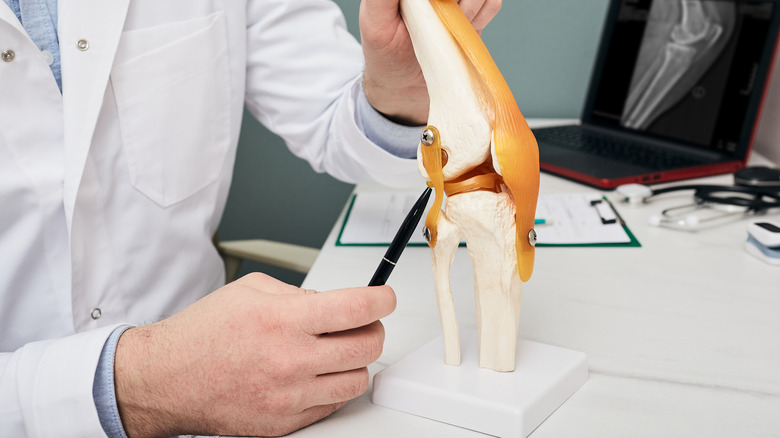What Happens If You Don't Repair A Torn Meniscus
Our knees — the largest joints in our bodies — are made up of bones, cartilage, ligaments, and tendons that are vital in keeping us moving through the physical demands of everyday life (per Boston Medical Center). As key players in our expression of movement with many essential working parts, it's no wonder the knees are cited as one of the body parts most vulnerable to injury. Of all the injuries our knees are susceptible to, among the most common is a torn meniscus (per Cleveland Clinic).
The meniscus is described by the American Academy of Orthopaedic Surgeons as two wedge-shaped pieces of meniscal cartilage that lie between the two bones that make up the leg — the femur (thigh bone) and the tibia (shin bone). Unlike other cartilage, meniscal cartilage is thick and rubbery, so it can act as a "shock absorber" for the joint. The Cleveland Clinic notes that meniscus tears are often a result of sudden twisting movements. While they're common in sports where cutting and pivoting are implemented, they can also happen while doing something as common as stepping out of the shower.
A torn meniscus can be painful and make it difficult to perform everyday activities, but treatment can help. Let's take a closer look at the diagnosis process, possible treatment options, and what happens if a torn meniscus is left untreated.
Diagnosing a torn meniscus
Because meniscus tears happen as a result of movement, Penn Medicine explains that you will likely feel and hear a pop at the time of the tear. Afterward, you might notice swelling and stiffness. You may also experience pain in the knee joint that feels worse when pressure is applied, and a feeling that your knee is giving out, locking, or catching when you bend it.
A torn meniscus is not something you can diagnose on your own. You'll need to have your injury examined by a physician with a specialty in orthopedics, who will likely order an imaging test, like an MRI or X-ray. This will determine the location of the tear, as well as the severity of it. Your options for treatment will vary depending on where and how badly the cartilage is torn.
While you may be inclined to go easy on your injured knee and see how it goes, Penn Medicine notes that receiving a diagnosis for a torn meniscus is imperative — leaving it untreated could lead to complications. Depending on the type of tear, meniscal cartilage has the potential of coming loose and slipping into the knee joint, which causes pain and diminishes the knee's ability to function properly. Left untreated, tears are also at risk of increasing in size and contributing to long-term knee problems, like arthritis.
Treatment options for a torn meniscus
When speaking with the Cleveland Clinic, orthopedic surgeon Dr. Richard Parker said that if you believe you have a torn meniscus, the first thing you should do at home is the RICE method: rest, ice, compression (with a wrap or a brace), and elevate. Dr. Parker states that if the pain persists, your doctor will likely recommend either physical therapy or arthroscopic surgery to repair the injured knee. Treatment for a torn meniscus depends on a number of factors ranging from your age to the overall condition of your meniscus. For example, if you're over 40 years old or already suffer from arthritis, physical therapy alone might work just as well as surgery. In some cases where there's too much wear and tear on the meniscus, surgery may not be a viable option. In these cases, Healthline describes how physical therapy can be used to strengthen the muscles that surround the knee, which can increase mobility and stability.
If physical therapy doesn't yield the desired results and you're a good candidate for the procedure, you may opt for arthroscopic surgery. It involves a small incision through which a camera and tools to repair the meniscus are inserted (per Healthline). In just about an hour's time, the meniscus can be repaired. Following six weeks of recovery and rehabilitation post-surgery, your knee can have the same mobility and functionality as it did before the tear.



